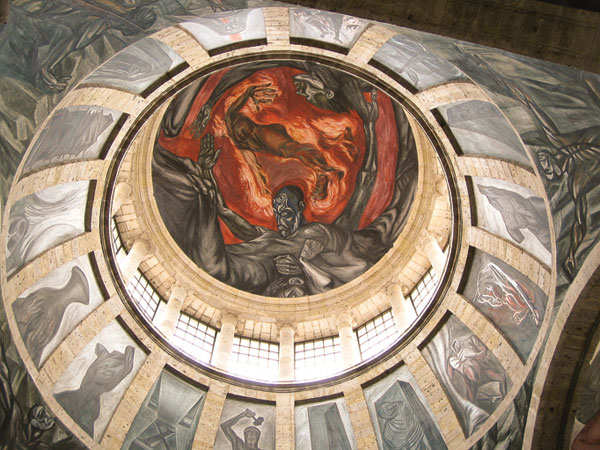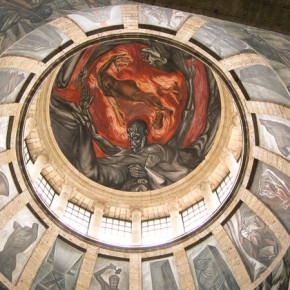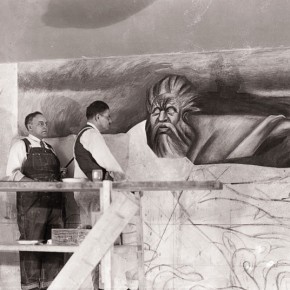
Hombre de Fuego (Man on Fire) 1938-1939. Government Palace, Hospicio Cabanas, Guadalajara, Jalisco, Mexico. Photo by Robert Guerra.
Unappreciated in his native land for much of his life, José Clemente Orozco was eventually hailed as “the greatest painter Mexico has produced” during the years preceding his death by none other than arch-rival Diego Rivera.
Orozco (1883-1949) dreamed of being an artist since early childhood, but tragedy struck before he was a teenager. First rheumatic fever damaged his heart. Then an accidental explosion cost him most of his eyesight and blew off his left hand. Accounts of the incident disagree, with potential causes varying from a lab accident to a fireworks explosion to playing with gunpowder.
What is not in dispute is that this amazingly talented, tenacious man eventually spent years of his life perched on scaffolds sometimes nearly 200 feet up in the air painting murals while wearing very strong glasses, attempting to maintain his balance without a second hand to steady himself.
Orozco started his career as an architectural draftsman but turned to drawing scathingly satirical political cartoons by his late twenties. Watercolors and oils came next. He was also a skilled lithographer, but at nearly 40 years old he found what he termed his true calling: murals. From then until he died of heart failure at 65, creating murals – many of them extremely controversial — became his passion.
Because of his strong revolutionary political beliefs, translated into murals prompting either love or hatred among viewers and sponsors, Orozco’s life was never smooth sailing. Deeply influenced by Porfirio Diaz’s lengthy and despotic regime, Orozco morphed into a man of radical beliefs, determined to portray through his art how hard it would be for Mexican peasants and workers to ever get a fair shake.
His mission, he felt, was a path he simply had to follow. “Painting,” Orozco said, “assails the mind. It persuades the heart.” Some critics contend no other artist of his time showed the human condition with more passion, skill and social realism than Orozco – a man of few words but many brush strokes. When asked to define art, Orozco replied, “Art is knowledge at the service of emotion.”
Along with Diego Rivera and David Siqueiros, Orozco was commissioned to paint murals in Mexico City in 1923. They became known as the “Big Three,” spawning what is called the Mexican muralist movement. Among Orozco’s first major works to show his own particular style is Omniscience, painted at Mexico City’s House of Tiles in 1925. (Now you can see it on the landing above the Sanborn’s restaurant currently housed in the building.)
A year later found him showing what things were like in post-revolutionary Mexico through a mural at the Industrial School in Orizaba, Veracruz. The result is not a pretty picture. Though President Álvaro Obregón initially supported his work financially, Orozco’s critical portrayals dried up the money flow. Feeling humiliated, Orozco left Mexico for the U.S. in 1927, where he painted for seven years.
During the last two years of his self-imposed exile, Orozco produced a 3,200 square foot mural titled The Epic of American Civilization at Dartmouth College in New Hampshire. Its twenty-four brilliantly colored panels cover Mexico’s history from the migration of the Aztecs to the development of modern industrialized society.
The pull of Mexico brought Orozco back in 1934. The following years found him in Guadalajara creating what are widely renowned as his masterpieces. One fresco – that’s a painting done directly on wet plaster – is called The People and Its Leaders. It sprawls throughout the Government Palace. Tourists routinely flock to the main staircase to see Orozco’s rendition of Mexico’s father of independence, Miguel Hidalgo, heroically brandishing a flaming torch.
The crowning glory is his series of frescoes in Guadalajara’s Hospicio Cabañas. There’s anxiety, crime, treason, tragedy and demagoguery on display in a very large space encompassing a series of arched panels and semi-circular vaults. Initially, there’s not much optimism in view, but one can lie on a bench under the nave’s cupola and gaze 195 feet upward to see Orozco’s most famous work, the awe-inspiring and life-affirming Man of Fire.
Though Orozco’s work in general is liberally filled with pessimism and despair, Man of Fire is an exception. Here you see a pure, incorruptible man prepared to sacrifice himself to divert the human race from what Orozco feels is its inevitable path to destruction.
Finally recognized as a national hero during his last decade, Orozco’s legacy also includes inspiring emerging generations of muralists in both Mexico and the United States from the 1930s up until today.
-originally published January 2011
- Hombre de Fuego (Man on Fire) 1938-1939. Government Palace, Hospicio Cabanas, Guadalajara, Jalisco, Mexico. Photo by Robert Guerra.
- José Clemente Orozco at work on The Departure of Quetzalcoatl, a panel of the mural The Epic of American Civilization at Dartmouth University 1932-33.
- José Clemente Orozco at work on The Departure of Quetzalcoatl, a panel of the mural The Epic of American Civilization at Dartmouth University 1932-33.
- Self portrait: Orozco Self- Portrait. 1940. Tempera on cardboard mounted on composition board. From the permanent collection at MOMA NY.






